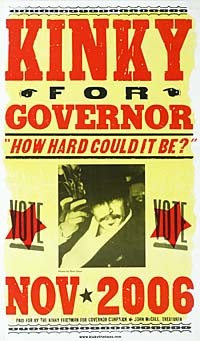HOW COMPLEX CAN IT BE?
Back in 2006, novelist and country music singer-songwriter Kinky Friedman ran (unsuccessfully) for governor of Texas. His campaign slogan, a rather pointed reference to the fact that recent occupants of the office George W. Bush and Rick Perry were not the sharpest tools in the shed, was "how hard could it be?" I can't answer that, but I can answer, after a fashion, the question of how complex or simple an Earth surface system can be.

An Earth surface system (i.e., geomorphic system, ecosystem, etc.) can be depicted as a series of components with connections or interrelationships among them. This can be treated as a mathematical graph, with the N components as the nodes and the m connections or interrelationship as the edges or links (for overviews of graph theory applications in geoscience and geography, see this, this, and this).
The adjacency matrix of such a graph is an N x N matrix with (in its simplest form) a 1 in the cell if the row and column components (nodes) are connected, and a 0 otherwise. The largest eigenvalue of such a graph is called the spectral radius, and is the single most common and important measure of graph complexity in algebraic or spectral graph theory. The upper bound of the spectral radius for a graph with a given N, m is

The most complicated possible configuration is where every node is connected to every other. In a state-and-transition model graph, for instance, this would imply that any state could transition to any other with no intervening steps. For this case, the value of the largest possible eigenvalue reduces to N - 1.
The simplest possible graph structure, assuming that each node is connected to at least one other, is a linear chain. For such graphs m = N - 1, and

For N > 2, this value asymptotically approaches 2 as N increases. Taking the ratio of the maximum and minimum values for an ESS graph of a given N, we come up with

As Mr. Friedman (below) would say, "why the hell not?" (another of his 2006 campaign slogans).

Posted 10/2/17
